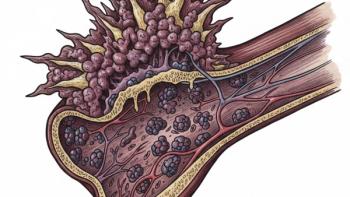
Examining the Role of Metabolic Pathways in Neuro-Oncology
Recent findings turned more attention toward the metabolic pathways in neuro-oncology.
In the field of neuro-oncology, there has recently been a renewed interested in studying the metabolic pathways of tumors, with the hope of developing novel therapeutic targeting in this area, says Howard Fine, M.D.
“It’s interesting, like a lot of things in science, something starts out hot and then we lose track of it for several decades. With new knowledge, all of a sudden there’s a whole new level of science brought to it, and I think that’s where we are with tumor metabolism,” said Fine, director, Brain Tumor Center, Sandra and Edward Meyer Cancer Center, and chief, Division of Neuro-Oncology, Weill Cornell Medicine.
In an interview with CURE, Fine discussed the reason for renewed interested in metabolic targets, the effect it has had on treatment of gliomas, and what he sees on the horizon for neuro-oncology in this area.
Why has there been renewed interest in metabolic targets?
Metabolism in cancer is actually an interesting story in that some of the earliest approaches we used to try to fight cancer, starting 30 to 40 years ago, tried to target the metabolic pathways, and some of our earliest drugs, like Trexall (methotrexate), to target cancer interfered with folate metabolism and that was really our major way of fighting cancer.
With the advent of molecular biology and genetics, metabolism and the idea of targeting the aberrant metabolism tumor kind of became passé, kind of like pharmacology did. We got in to the genetic age and people began to forget about it, until we began to realize that many of the oncogenic pathways and many of the deregulated signal transduction pathways that we’ve been studying actually end up converging on pathways of metabolism.
There’s been an increased interest in all [areas] of cancer, and certainly neuro-oncology, to not only begin to really understand the aberrant metabolism in tumors to better understand tumor biology, but also to realize that there may be great opportunities for novel therapeutic targeting.
What was the significance of this finding?
This particularly came to light with the discovery five, six or seven years ago, of the IDH mutation found in a large percentage of low-grade gliomas. The IDH mutation is in a gene that is central in the tricarboxylic acid (TCA) pathway and is a basic metabolic enzyme. That again brought to light how intrinsically important metabolism is in tumor biology, glioma biology, and the potential therapeutic options thereof.I think that brought a lot to light. In fact, it’s the first mutation that has been shown in a TCA enzyme that produces a unique metabolite that’s now called an oncometabolite. It’s kind of the paradigm for how metabolism is important for any cancer, so it has a special place in the heart of neuro-oncologists.
What do you think is on the horizon, and what are you hoping to see?
I think that increasingly so, in all of oncology, people are beginning to pay a lot more attention to the importance of cancer metabolism and how it may offer new therapeutic opportunities. I think IDH1 is just the tip of the iceberg, although I don’t know that we’re going to find that many new mutations in oncometabolites. It is quite clear, and we’ve know this for many, many years, but now we’re beginning to really understand the molecular details of it, that the metabolism in tumors is quite dramatically different than it is in normal tissue.
When you think about therapies, what are we trying to do? We’re trying to find ways in which tumor tissue is different and behaves different and has a different biology than normal tissue because that gives a therapeutic target. If you can find the therapeutic ratio that’s different between normal tissue versus tumor tissue, that gives you something to aim at therapeutically without worrying about overlapping normal tissue toxicity. Metabolism is just that—it’s a very complex series of biochemical pathways that appear to be, in many respects, quite different in tumor tissue than in normal tissue; so it offers, theoretically, a very promising new area to therapeutically target.
What are the effects of stress on the tumor metabolic environment?
I hope to see, and I think we will see, whole new strategies based on developing drugs against these novel metabolic targets and in fact, possibly even diet modifications. There has been a lot over the last 10 or 20 years about special kind of diets, like ketogenic diets, that effectively target metabolism. I know they haven’t been studied well, they haven’t necessarily been done in the correct way—they haven’t been done in conjunction with pharmacologic intervention. I think we’re going to see those types of strategies. I know we will, because we’re doing those types of strategies at our center and in other centers, and I think it’s a great unexplored and an exciting old/new area.We know that stress causes hormonal changes and hormonal changes are involved in metabolism. For instance, we know that stress induces glucocorticoids and causes adrenal hyperactivity. When you get high levels of adrenocorticotropic hormone (ACTH) and steroids, you increase insulin levels. We know that insulin drives tumor growth and tumor promotion. Although there’s no data, one could speculate that high levels of stress hormones over long periods of time may increase insulin, and may increase your chances of type 2 diabetes, which has been shown, and we think that high levels of insulin resistance, hypoglycemia, certainly can help fuel tumor metabolism.
Does age play a factor in metabolic pathways?
Are there any ongoing trials that you are currently watching with interest?/strong>
The answer is we don’t know, but I’m sure that it does. We know that for instance in a normal aging brain, metabolism is dramatically different than it is in developing in a middle-aged brain. That is well established and there’s an increasing number of papers being published looking at the molecular mechanism of that. If the normal surrounding brain metabolism is different, tumors don’t live in isolation, they live within the host, so I’m sure the metabolic profile and the details of the metabolism of tumors in an older versus a younger brain is quite different, but I think we are just beginning to explore those aspects. Certainly, there is a whole series and it’s a big focus on a whole new series of drugs that target this mutant IDH gene, so these IDH inhibitors are being explored now both in low-grade and high-grade gliomas with variable success. I think we’re just beginning to learn to use those.
Centers like ours are looking at the old kitogenic diet in combination with very specific new pharmacologic interventions like PI3 kinase inhibitors and mTOR inhibitors as a way of trying to hit the metabolism in various fronts of tumors. Those kinds of trials and therapeutic interventions are just beginning to be seen.





